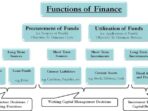Financial Depth Adalah – In the previous post of the Blog series of financial depths, we tried to understand the nature of the relationship between financial depth and economic growth. The next natural question is how to measure the financial depth. This post answers this question from:
Early literature used the general credit ratio of the bank to gross domestic product (currently GDP) as an indicator of financial depth [1]. Nevertheless, private firms are more likely to stimulate growth, evaluating their risk and corporate control ability than state state loans or companies [2]. Consequently, the internal loan coefficient, borrowed in the private sector with GDP, has currently become the most used indicator of the financial depth of the economy. Thus, private lending excludes the loan issued to government, state institutions and state enterprises. It also eliminates a loan issued by central banks [3].
Financial Depth Adalah

However, in the context of developing countries, it is reasonable to assume that the pension fund, mutual fund and insurance markets were not properly developed for use as a financial depth. Thus, a loan in the private sector in PBB remains the most widely used financial depth.
Exploring Financial Ratios For In Depth Credit Analysis
The measures discussed above are not devoid of their restrictions. This section discusses why these measures are inappropriate for understanding excessive credit insurance in the economy. The data below are the main restrictions [5]:
1) to ignore heterogeneity in credit demand in different countries: these measures ignore that the demand for credit in all countries varies depending on their level of economic, financial and institutional development. The main managers of this heterogeneity of demand in all countries are changes in financial depths, access to financial services, the use of capital markets, efficiency and financing of local banks, the independence of the Central Bank, the degree of supervisory integration and the experience of the financial crisis.
Figure 1: A bank loan can be a fraudulent measure of financial depth and access – Korea and Vietnam have similar values of the bank’s depth – a private loan for GDP. However, they change with a large sum in terms of access. The use of bank accounts is almost universal in Korea, but in Vietnam, only a quarter of adults have a bank account. [6]
2. This assumption was violated, especially for developing countries from various use of a loan in economic operations from various levels of development.
Makarim & Taira S
3) It is assumed that the variables of the financial depth are stationary: a stationary variable is that the statistical properties of which are average, dispersion and autocorrelation, constant over time. The coefficient of loan to GDP empirically indicates that this is a variable trend, which means that the loan increases much faster than the nominal GDP.
4) cannot achieve the effect of financial deepening at the subnational levels: although the traditional measures used are built using ready -made macroeconomic data, they reflect macroeconomic results in financial deepening. In other words, they do not necessarily reflect how well the finances perform different functions at different levels of the economy.
Consider the case of measuring the financial depth in India, where the depth of financial services is significantly different between different regions. Ideally, the cost of an INR 1 loan in a hungry credit circle should be greater than its cost in a circle, which is relatively suspended from credit. Inclusix, published by Crisil, which is an objectively measured financial integration index, provides a result for each circle (out of 100), and 100 indicate a fully financially involved area. [7] The results in the index vary from 96.2 for the Pattananamitta area in Kerala, at a low level of 5.5 for the Kung Kumai in Arunal -Pradesh. This suggests that there is an integral need to calculate subnational changes that the proper level of financial depth in the economy [8].

The measure of financial depth, which is removed with the restrictions on traditional measures discussed above, is “equilibrium loan” [9]. This is an important concept, because it helps to determine excessive and insufficient credit insurance at the subnational levels of the economy. In other words, an equilibrium loan helps to determine the standards by which credit insurance at different levels of the economy is considered excessive or not. In the next post, the idea of balance is discussed in detail.
In-depth Analysis Of Indonesia’s Top 10 Banks: Navigating Growth And Risk In A Dynamic Economic
[7] Report, the Committee on Comprehensive Financial Services for Small Enterprises and Senities with Low Revenue. 2014, represented by the Indian Reserve Bank. https://rbidocs.rbi.org.in/rdocs/publicationreport
In all our research efforts, we try to support an independent voice that speaks of home and home -made home -made enterprises. Our ability to fulfill this function was significantly improved thanks to our obligations to spread as a purely public good, all the intellectual capital that we create.
This function is available only for registered users. Please register or enter the system to save it in your reference library. Monetary economists spent most of the last decade, taking into account the swollen balance of the Fed. Was a large balance of effective monetary policy discovered? Should the Fed must sell its assets in return to normal state? Nevertheless, it is often overlooked in this discussion, affects the main balance of bank lending and true economic growth. Both have been slow since 2008. Perhaps the remainder of $ 4.5 trillion is partly to blame.
Financial systems play an important role in the process of economic growth. Of course, the most important channel through which finances contribute to growth is a financial deepening or degree in which the private sector allocates a loan. Intuition is simple. Private financial institutions specializing in savings in the direction of profitable production investment. These investments laid the foundations for sustainable economic growth and development. Thus, part of the money issued by a private bank in the economy provides a reasonable assessment of the financial depth and, the higher the ratio, the higher the prospects of true economic growth.
Kaf Sekuritas Indonesia
Unfortunately, this report has quickly fallen in the United States since 2008, when the Fed began to expand its balance. Over the previous decade, the financial depth of the United States is on average about 87.89 percent. Since 2008, it has an average of 76.24 percent. Although there are many factors, the Fed’s policy for paying interest of member banks for excess reserves is probably a leader of them. Simply put: Fed is encouraging banks to collect excess reserves than to contribute. Economic growth suffered as a result.
Goods, what wealth do you hold the Fed? Since December 2017, a little more than half (54.69 percent) of the Fed’s balance sheet consists of securities of the American treasury. Entire papers associated with a mortgage are another significant part (39.42 percent). Together, these two categories are 94.11 percent of the Fed’s ownership – a not quite powerful recipe for a healthy and bright economy.
The massive balance of the Fed is almost certainly collecting private investments – private investments that will contribute to economic growth. Moving forward, we need to know the important role that private financial institutions play in grinding the wheels of the economy. The swollen balance is expensive. The Fed must reduce its balance. While the money issued by a private bank in the economy is returned to more reasonable levels, as well as to the level of economic growth. The IMF has just published a new note on the discussion of employees entitled “Finance and Inequality” by Martin Chikhak and Ratna Sakhai. The shortest summary of his conclusions: many finances make places more uneven. And, according to the new Director of the IMF Management, Kristalline Georgova, representing the study, an increase in inequality:

He remembers the early part of the 20th century – when the double forces of technology and integration led to the first gilded era, a twenty -year -old noisy and, ultimately, financial disaster.
Pdf) Financial Depth And Financial Access In Indonesia
This is the last in the sophisticated body of academic research, which supports the thesis of the curse of finance: the idea is obviously paradoxical that “many finances can make you poorer.” In other words, countries should develop financial sectors, but only to the optimal point of view, and if finances go beyond the scope of this point, this tends to damage the economy and the company that expect it. Many Western economies have long spent this moment.
We will start with a very deep line in the text of the report, which is quite explosive. In the section on the consequences of politics, this recommends:
This is our accent, boldly. Here is the IMF, which says that countries should not allow its financial sectors to grow too much. This recommendation concerns inequality, but the IMF not only came to the idea that inequality is damage to growth: he published several reports demonstrating the thesis about the curse of finance: this
(And gives the burden of other economic and social losses.) As we said earlier: Shrrink Finances, for prosperity.
Different Types Of Islamic Financial Instruments In Depth Analysis Of Islamic Banking Background Pdf
In more detail, this new article discusses “financial depth”, which means the size of the country’s financial sector in relation to the economy. Its title graphic schedule looks like this:
This schedule of Guinea (the measure of inequality, the lowest number is better) against the “financial depth” (as measured by a separate set of data from the IMF). In the report, this explains this in the shortest possible time:
We find that the financial deepening reduces the inequality of income within the country, after which the inequality begins. Pole Pole Growth







